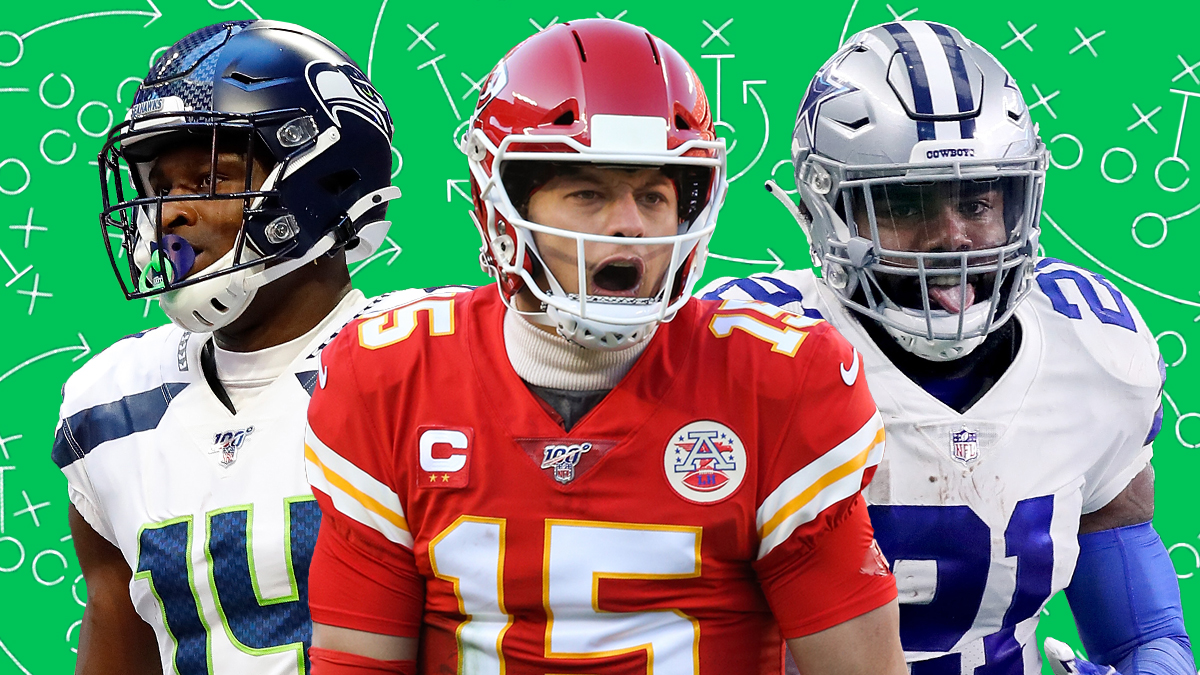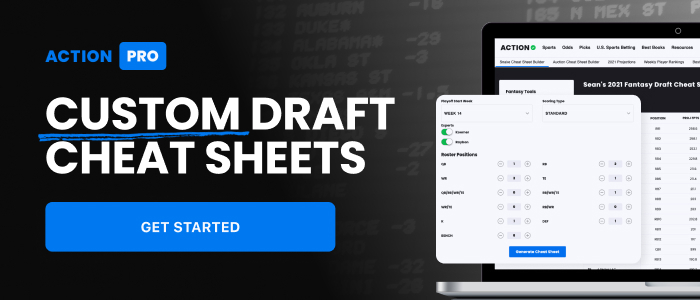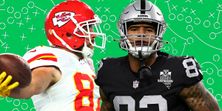2021 Fantasy Draft Strategy & Tiers: Your Guide To Drafting QBs, RBs, WRs & TEs This Season
Getty Images. Pictured: D.K. Metcalf, Patrick Mahomes, Ezekiel Elliott
- Getting ready for your next fantasy football draft? We've compiled Sean Koerner's strategy for every position below.
- Find out how he's drafting quarterbacks, running backs, wide receivers and tight ends heading into the 2021 NFL season.
Sean Koerner — FantasyPros' most-accurate draft ranker of 2019 — is breaking down his draft strategy for every position. The following story features excerpts from his 2021 Tiers Series, which is where he breaks his rankings down into "tiers" so you can actually apply them clearly to your draft strategy.
The tiers linked as part of his comprehensive draft strategy breakdowns are as of Aug. 13, but you can find his latest tiers as of Aug. 27 here — or see real-time updates to his rankings through our 2021 Fantasy Draft Kit, which is part of our PRO subscription.
2021 Fantasy Football Rankings
| Click On A Position To Read Those Tiers |
|---|
| Quarterbacks |
| Running Backs |
| Wide Receivers |
| Tight Ends |
2021 Fantasy QB Draft Strategy
My quarterback draft strategy changes drastically based on whether it's a 1QB or 2QB/Superflex format.
In a 1QB format, your league will typically draft only 13-15 QBs, meaning 17-19 starting QBs will be available on the waiver wire each week — that's why streaming QBs in-season can be a viable strategy.
If I don't land one of the top six QBs in 1QB formats, I'll likely punt the position and plan on streaming in-season.
Just because you begin the season streaming QB does not mean you'll be relying on the Kirk Cousins or Derek Carrs of the league all season long. Every season, it seems I stumble on a full-time QB1 at some point during the season. Last season, I ended up with Justin Herbert or Jalen Hurts in leagues in which I didn’t even draft a QB.
The moral of the story is that you don't have to draft a QB in 1QB leagues, and in some cases, it can be a winning strategy.
On the other hand, 2QB/Superflex leagues make the QB position much more valuable in fantasy (as it should be). The primary reason for that is easier to understand when looking at the projected points chart (below).
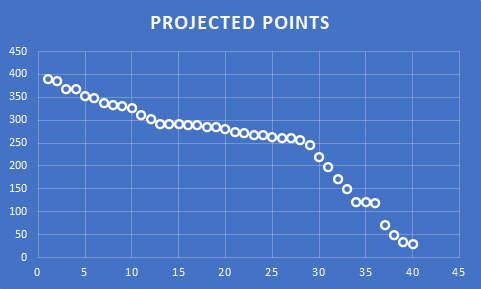
As you can see, there's a massive drop-off right after the QB30 is off the board. It makes sense when, considering at any given time, there are only 32 starting QBs. Therefore, you can get yourself into trouble in 2QB/Superflex formats if you don't have 2-3 starting QBs at any given time.
Because of this, it's a race against your league to draft 2-3 QBs, making them a precious asset in that format (which is much closer to how valuable QBs are in real life and is why I prefer these formats).
2021 Fantasy RB Draft Strategy
Running back continues to be the most critical position in fantasy football.
There are two main reasons RB typically decides the fate of your team each season:
- As the NFL becomes an increasingly pass-heavy league and RBs are deployed for specific purposes, there are fewer workhorse backs. Positional scarcity makes it critical to draft at least two workhorse RBs.
- The position is very volatile. RBs are the most likely players to miss time due to injury, or to lose their job. Given the position is much more about opportunity rather than talent, it paves the way for late-round picks or even waiver wire pickups to emerge as league winners.
Because of those two factors, there are a lot of draft strategies focused solely on how many RBs you should acquire early on.
On the opposite end of the spectrum is the Zero RB strategy, which I agree with … in theory. It mainly focuses on Reason No. 2 above, but ignores Reason No. 1 — that’s why I would dub my approach as the RB Surplus Strategy: I first aim to draft two RBs before the end of Round 3/4 because, as I mentioned, it’s critical to acquire two who are set to open the season with a reliable workload. Then I target high-upside backs in the middle and late rounds.
Another important component of your draft strategy should be to understand the purpose of your bench. Generally, you don’t want to waste a bench slot on a quarterback or tight end — it’s very easy to find a replacement for either position on the waiver wire if you’re ever in a pinch or in need of a bye-week fill-in.
If I have seven bench slots, I’ll usually aim to fill them with two to three WRs and four to five high-upside RBs.
The goal of stashing high-upside RBs, specifically, is to hopefully strike gold if one earns a one-off start or becomes their team’s starter indefinitely. Think about the backup RBs who usually require a No. 1 waiver wire claim or the highest Free Agent Acquisition Budget (FAAB) bid to acquire when injury or depth chart news breaks mid-season — I can’t tell you how many times a RB who fits that profile was already on my bench.
Drafting RBs with the highest potential to be league winners allows me to be even more aggressive when I do have first priority on waiver wire claims or still have a high percentage of my FAAB available. To help you easily identify them, I’ve ranked backups by their upside here.
The chart below illustrates just how valuable the first handful of RBs drafted are — they offer such a significant edge over your leaguemates, hence why they're typically the first four picks of the draft.
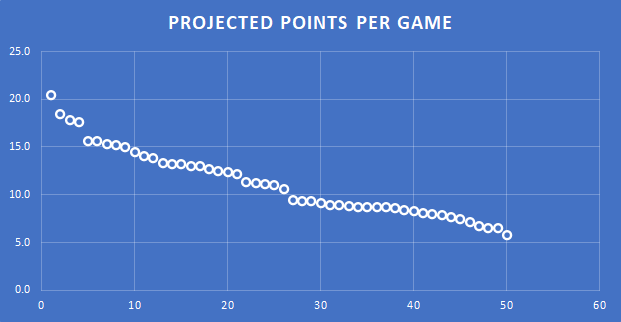
You can also see where the position features steep drop-offs. I aim to draft at least two RBs before the drop-off right outside the top 20, and three before the next drop off in the mid-20s.
Once a draft enters the RB30 range, your strategy depends on what type of RBs you're looking for. That's why, as part of these tiers, I attempted to create "buckets" that help you identify what exactly certain backs can offer you and when you’ll want to target them.
2021 Fantasy WR Draft Strategy
Running back is the most critical position in fantasy football, but wide receiver is a close second.
With the depth at WR, it’s easy to become complacent while drafting — if you miss out on a specific tier of WRs, you think there will be more talent to choose from later. But you have to be careful not to neglect the position so much over the first six rounds that you end up with Deebo Samuel as your WR2.
If WR has ever been the weakest position for one of your teams, you know it can feel like an uphill battle. One reason is the position is more volatile week-to-week, and there aren’t the same short-term buy opportunities when a starter misses time.
We all know that when a starting RB is injured, the door opens for a backup to see instant fantasy value. Unfortunately, WR doesn’t offer the same upside. For example, if Adam Thielen were to miss time for the Vikings, Dede Westbrook could get the nod to start in 2-WR sets, but it’s unlikely he would be playable in most leagues.
The takeaway here is that it’s important to spend significant draft capital to lock in your WRs. For example, if you're in a three wide receiver league, it's essential to have at least two before your draft reaches Tier 8 and three before Tier 9 is off the board.
Remember, our entire goal is to take players before the steep drop-offs at the end of a tier.
It's easier to visualize this when looking at the projected points per game for the top 65 WRs:

2021 Fantasy TE Draft Strategy
The tight end position perfectly illustrates why it's crucial to view fantasy football rankings in tiers that you can build your draft strategy around.
First, take a look at my projected points per game for the top 25 TEs:

When drafting based on my positional rankings, it's essential to realize that not all rankings should be treated equally — the key is to identify how much the position drops off after a player or tier is off the board.
It's easier to visualize this phenomenon by looking at the chart above. You can see the steep drop-off from the top three TEs to the three-player cluster around TE5 (Tier 4), then the position levels off quite a bit.
My draft strategy revolves around targeting players who represent a steep drop-off within their position, typically taking a player at the end of a tier rather than at the beginning.
I break it all down in my tiers. Here are the key areas I highlight:
- Why Travis Kelce and Darren Waller are worth their Average Draft Position (ADP)
- Why Tier 4 is the most critical one of all (and how that makes T.J. Hockenson the most important TE in my draft strategy)
- Why we should avoid Tier 5 altogether
How would you rate this article?

